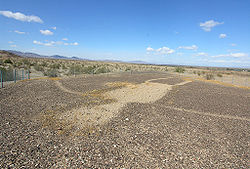
Back Блайцкія фігуры Byelorussian Блайтски инталии Bulgarian Obrazce v Blythe Czech Blythe Intaglios Spanish Blythe Intaglios French Блайтские фигуры Russian Blythe Intaglios SIMPLE Obrazce v Blythe Slovak Блайтські фігури Ukrainian
Blythe Intaglios | |
California Historical Landmark No. 101 | |
 One of the Blythe Intaglios, 2007 | |
| Nearest city | Blythe, California |
|---|---|
| Coordinates | 33°48′01″N 114°32′18″W / 33.80028°N 114.53833°W |
| NRHP reference No. | 75000452 |
| CHISL No. | 101 |
| Added to NRHP | August 22, 1975 |
The Blythe Intaglios or Blythe Geoglyphs are a group of gigantic figures incised on the ground near Blythe, California, in the Colorado Desert. The ground drawings or geoglyphs were created by humans for an as-yet-unknown reason.
The intaglios are located east of the Big Maria Mountains, about 15 miles (24 km) north of downtown Blythe, just west of U.S. Highway 95 near the Colorado River. The Blythe Intaglios are the most well-known of the over 200 intaglios in the Colorado Desert.[1] The Colorado Desert contains the only known desert intaglios in North America.[1] These intaglios are mostly located along the Colorado River.
The Blythe Intaglios contain three human figures, two four-legged animals, and a spiral; although Harner (1953) reported two spirals.[2] The largest human figure in the Blythe Intaglio group is 171 feet (52 m) long. The intaglios are best viewed from the air.
Geoglyphs are found throughout the world, the construction methods ranging from earthen mounds, piles of stone, or the removal of surface plants or soil. The most famous desert intaglios are the Nazca Lines in Peru.[3] The Blythe Geoglyphs or intaglios (anthropomorphic geoglyphs) were created by scraping away layers of darker rocks or pebbles to reveal a stratum of lighter-valued soil. The displaced rocks outlined the figures and the exposed soil was stamped down which makes it more difficult for plants to grow in the lines. The intaglios are located on flat terraces in the Colorado River floodplain.[2]
While these "gravel pictographs" are found through the deserts of southeastern California, human figures are found only near the Colorado River. Other intaglios depict mountain lions, birds, snakes and unidentified zoomorphic and geometric shapes.[1] The figures are so immense that many of them were not observed by non-natives until the 1930s.[4] The set of Blythe Intaglios and nearby geoglyphs include several dozen figures, thought to be ceremonial in nature.[5]
No Colorado River Native American group has claimed to have made the intaglios, although some have claimed to use them.[2] Many of the intaglios are believed to date from the prehistoric period, but their age and the identity of their creators are still uncertain. If the quadruped figures represent horses (reintroduced in North America by the Spanish) then a historical date would be supported.[2] Jay von Werlhof and his collaborators obtained 13 AMS radiocarbon dates for the figures, ranging from 900 BCE to 1200 CE.[6]



- ^ a b c Leska, Amy (2008). "A brief introduction to the intaglios of the Mojave Desert". Trough to Trough: 125–26.
- ^ a b c d Harner, Michael (1953). "21. Gravel Pictographs of the Lower Colorado River Region".
{{cite journal}}: Cite journal requires|journal=(help) - ^ Maillard, Frederico (2009). "Geoglyphs on the Har Karkom Plateau (Negev, Israel)". Papers, XXIII Valcamonica Symposium 2009: 208–14.
- ^ Gilreath, p. 288
- ^ Gilreath, pp. 288–89
- ^ von Werlhof et al. 1995.

